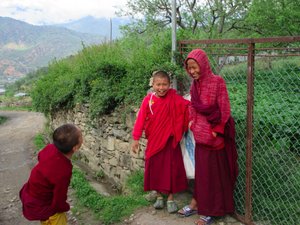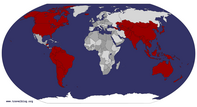Advertisement

 Chpmunks
Chpmunks
The kids that followed me around.The world is full of surprises and novelty if you open up to it, the last several days in Asia made that ever more clear.
We left Bhutan to spend a couple more days in Nepal before the flight home. But before leaving I took a walk away from the hotel through a couple of neighborhoods in Para, Bhutan.
I was joined by three young monks, looking to be about 7 to 13 years old. They laughed and joked with me, wanting to know if I found their country beautiful and then, after I said it was, delighted in pointing everywhere a dog had pooped along side of the road. Ah, Buddhist monk humor.
I also had a close up look at the farms. All of them are terraced, winter wheat now being harvested and rice patties planted in preparation for the monsoon rains that will keep the beds flooded. Every farm seems to have a cow or goats, which provide the dung they mix with pine needles for compost, the spreading it for the crops.
The most interesting sight along the walk was a house that was being built by a team of carpenters, masons, and

 Plans?
Plans?
Master carpenter working without plans. To steal from "The Treasure of the Sierra Madre": Plans? We don't need no stinkin' plans.laborers. What I realized was that all the raw materials had been dumped at the site, piles of rock, sand, cement, and a larger pile of 'boards' looking to be about 16 feet long and about 8x10" in size. The master craftsman was under a tarp, measuring, coming out and choosing lumber, and directing the staff to cut the boards and stone to size, there was no finished or dimensional lumber on the site, they created it all as they needed it with chisels on the stone and a chain saw on the wood. When I asked the master where the plans were, he just smiled and pointed to his head.
Our flight out of Para was delayed due to clouds. I was alright with the delay as we had been told that the Bhutan international airport is one of the most dangerous in the world--thanks for that bit of news the day before we were to fly out. In fact, only eight pilots are licensed to fly into or out of the place. Something you are reminded of as the plane banks back and forth rising out of the valley with mountain peaks often visible at our level

 Sharing
Sharing
Apple orchards are everywhere, and always do double duty. Many have other crops under them, potatoes and peas often. Some provide grazing for livestock, who are allowed some of the apple crop in return for the fertilizer they leave behind.right outside the window.
Above the clouds at about 30,000 feet we had great views of Everest and other peaks rising up above the cloud cover.
In Nepal we spent one day hiking through a small village and observing the farms that surrounded the town. At the last moment I found a small bakery and grabbed a couple of donuts and chatted with the shop keeper. As we walked through the town children ran out to try out their English on us. What fun.
Thursday, our final day in Nepal began with an interesting observation at breakfast. In the hotel restaurant we were joined by a group of six monks, a yogi, and a woman with a baby all at the same table. I made up a story about them being their to receive the child into the monastery. Turns out the story I made up was fact. We heard from one of the group that the child was a reincarnation that they were talking with them to the monastery. Fascinating.
After breakfast we struck out on our own for Asan Tole. This is a dense cluster of streets and shops, one of the most crowded

 Everest above the clouds
Everest above the clouds
Flying from Bhutan back to Nepaland exciting places we visited. We started with the spice shops, picking up cardamom and various rock salts from the Himalayas.
Then we wandered through the food district with piles of bananas, vegetables, and hunks of meat waiting for the chopping block. Another road was full of clothiers, with shoes, saris, and bolts of cloth flowing out into the street. Bead sellers took up another area, and everywhere there were small shops with sweets, crackers, soap, and more.
As it was morning, each shop keeper was setting out the wares, and spending a great deal of time dusting them off. Feather dusters, hair dryers, all sorts of tools spruced up shoes, kettles, kitchen tools and more. And despite the trash in the road ways, each shop keeper worked to clean the space before his/her shop with water and a good sweeping. The difference between personal and public property was no more clearly displayed than by the clothing store owner who swept up trash on her stoop, put it in a plastic bag, and then tossed it out into the alley.
Electioneering was going strong, as the polls open on Saturday for the first round of local elections

 Dung
Dung
Dung was collected from stables at homes and hauled to the fields to be spread. Nothing is wasted.so today was the last day of campaigning (no campaigning the day before the election). Groups of supporters of various parties parade through the streets with drums banging. We watched as at one corner voters lined up to get their voting card. They were printed in big books, and you provided your identification card and were given a voting card.
On the way out I found another bakery and indulged in my favorite Nepali delicacy, a jellie, which is like a mini-funnel cake that is fried and then drenched in honey. Ahhhh....
In the afternoon there was one more treat. Back in December at a conference I had met Madhab Sitaula, the principal and founder of Lalitpur School. Educating children from ages 3 to 16, the school is a 'trust' school, they charge tuition but do not make a profit. In fact, they do a great deal of charity work, charging 700 students tuition but taking in 900 kids, 200 of them charity. (Another 200 girls also attend for free, their tuition paid by a foundation that supports girls' education.)
To explain, there are three types of schools in Nepal, government which are free, trust like this

 Streets of Asan Tole
Streets of Asan Tole
Motorcycles, cars, vendors, and shoppers crowl the narrow alleys.one, and private schools that are run for a profit for shareholders.
Madhab's school has been heavily influenced by the ideas of Dewey and progressive educators in the US. We visited the campus, but, unfortunately there were no students as it was a holiday. But we saw the classrooms and met Madhab's sister who runs the elementary school. The program and philosophy are great! Madhab had been in the states some seven years ago and brought back the progressive philosophy he had learned to the school. Wisely, he had decided he would introduce this at kindergarten, or Level 1, first and work it up through the grades. This year it permeates Levels 1 through 6 and next year will spread to the secondary school.
What makes the program even more impressive is that his sister, Gita, runs an evening school for mothers, many who are illiterate, teaching them to read and coaching them on parenting. She also mentors each teacher, developing lesson plans, co-teaching, and pressing on the philosophy. This teacher-training is so important as the individuals they hire to teach are high school grads (no teacher preparation programs in Nepal) who only know how to teach as
they were taught, as in stand in front of children, lecture, and have them repeat. She is an administrator, parent educator, and teacher educator--a real advocate for children and families. It was so inspiring to see how much they do with so little.
After the tour, Madhab wanted us to come to his home for lunch, he had arranged a taxi for us, but when I saw that he was going by motorcycle, well, I asked if I could ride with him. The next thing I knew I was in the midst of the dodging, happy, lane oblivious crowd of cycles, buses, and cars, zipping through the dust and traffic on the back of a motorbike.
Lunch at their home was wonderful, typical Nepali vegetarian food, well prepared by his wife and shared with his three handsome and welcoming daughters. Marcia invited the youngest, Annama, to visit us in the US and she said she might 'come down' and see us...as in, come off the mountains. How nice it was to sit in their kitchen and feel so welcomed and taken care of. When the taxi honked outside, driven by the parent of one of their students, I
did not want to leave.
I am finishing this up sitting at my dining room table, still a bit 'gob smacked' by all we have seen and done. Since getting home several folks have asked what was the most outstanding moment...but I cannot choose.
What I can say is what we will remember the most, of course, are the people we met, and those we did not. People who invited us into their homes, who wanted to show us their work, children who would smile broadly even if we just waved from the bus, and guides who spent so much time patiently explaining to us how these nations worked. Most importantly, all of them were filled with hope for a better future, and were working hard on making it happen.
One more thing to take away. The Buddhist teaching that I will try to remember and that seems central to everything we saw, was that three things stop you from reaching enlightenment: The pig which symbolizes ignorance, the bird which symbolizes desire, and the snake which symbolizes anger. May we all avoid being like the pig, bird, and snake; seems like a good plan to me.
Advertisement
Tot: 0.242s; Tpl: 0.012s; cc: 18; qc: 73; dbt: 0.0891s; 1; m:domysql w:travelblog (10.17.0.13); sld: 1;
; mem: 1.2mb












